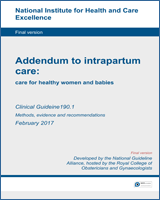From: Appendix I, GRADE tables

NCBI Bookshelf. A service of the National Library of Medicine, National Institutes of Health.
| Quality assessment | Definition of outcome | Total number of CTGs | Measure of diagnostic accuracy (95% CI) | Quality | ||||||||
|---|---|---|---|---|---|---|---|---|---|---|---|---|
| Number of studies | Design | Risk of bias | Inconsistency | Indirectness | Imprecision | Sensitivity | Specificity | Positive likelihood ratio | Negative likelihood ratio | |||
| CTG interpretation identified as abnormala by a computer software program | ||||||||||||
|
1 | Retrospective cohort | Serious1 | No serious inconsistency | Serious2 | Very serious3 | pH < 7.15 | 73 |
87.50 (46.7 to 99.3)b |
75.40 (62.9 to 84.9)b |
3.55 (2.16 to 5.86)b |
0.17 (0.03 to 1.05)b | Very low |
| CTG interpretation of an outcome as abnormalc by a computer software program | ||||||||||||
|
1 | Retrospective cohort | Serious1 | No serious inconsistency | Serious2 | Very serious4 | 1-minute Apgar score below 7 or acidosis (umbilical arterial pH < 7.15 or base excess below −10 meq/l), or primary resuscitation needed | 50 |
68.8 (41.5 to 87.9)b |
94.1 (78.9 to 99.0)b |
11.7 (2.9 to 46.7)b |
0.33 (0.16 to 0.69)b | Very low |
CAS Cardiotocographic Assessment System; CI confidence interval; CTG cardiotocograph; FHR fetal heart rate
An abnormal trace was defined by one or more of the following criteria
Calculated by the 2017 NGA technical team
A computer system (CA) calculates the probability of the CTG belonging to a compromised infant by calculating a discriminant function, and a CTG is considered pathological if the probability is above 0.5. The computer system’s calculation of the probability of a compromised infant is for each CTG based on the experience from the other 49 CTGs, thus excluding the possibility of “self-recognition”
Selection of cases for assessment not well described and it is unclear whether a consecutive or random sampling approach was taken
The reference standard used was different to that specified in the guideline review protocol (arterial cord pH <7.05)
CI for the negative likelihood ratio crosses two boundaries (from very useful (< 0.1) to not very useful (> 0.5)
CI for the positive likelihood ratio crosses two boundaries (from very useful (> 10) to not very useful (< 5))
From: Appendix I, GRADE tables

NCBI Bookshelf. A service of the National Library of Medicine, National Institutes of Health.